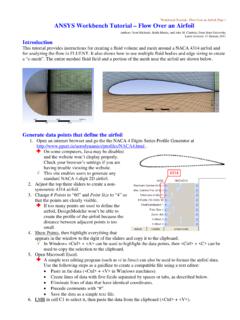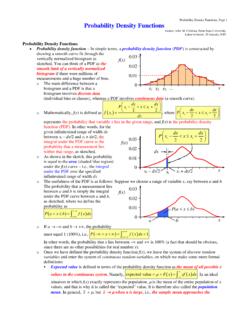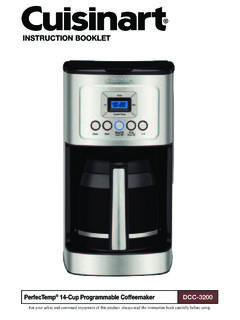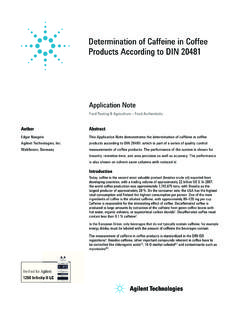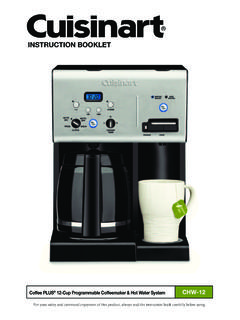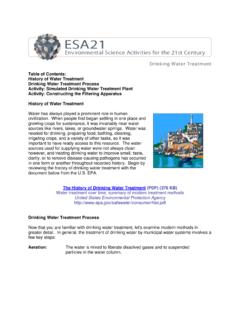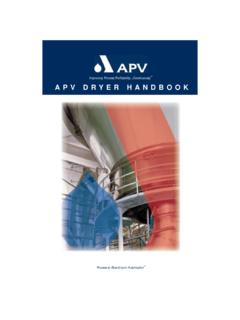Transcription of Activated Carbon (Charcoal) Filters
1 Activated Carbon (Charcoal) Filters (Used mostly for water, but also can remove gas pollutants from air). From : Activated charcoal is charcoal that has been treated with oxygen to open up millions of tiny pores between the Carbon atoms. From : Carbon filtering is a method of filtering that uses a bed of Activated Carbon to remove contaminants and impurities, using chemical adsorption. Each particle/granule of Carbon provides a large surface area/pore structure, allowing contaminants the maximum possible exposure to the active sites within the filter media.
2 One pound (450 g) of Activated Carbon contains a surface area of approximately 100 acres (40 Hectares). Activated Carbon works via a process called adsorption, whereby pollutant molecules in the fluid to be treated are trapped inside the pore structure of the Carbon substrate. Carbon filtering is commonly used for water purification, in air purifiers and industrial gas processing, for example the removal of siloxanes and hydrogen sulfide from biogas. It is also used in a number of other applications, including respirator masks, the purification of sugarcane and in the recovery of precious metals, especially gold.
3 It Image from is also used in cigarette Filters . Active charcoal Carbon Filters are most effective at removing chlorine, sediment, volatile organic compounds (VOCs), taste and odor from water. They are not effective at removing minerals, salts, and dissolved inorganic compounds. Typical particle sizes that can be removed by Carbon Filters range from to 50 micrometres. The particle size will be used as part of the filter description. The efficacy of a Carbon filter is also based upon the flow rate regulation. When the water is allowed to flow through the filter at a slower rate, the contaminants are exposed to the filter media for a longer amount of time.
4 From : Charcoal Filters are used in a variety of fashions. The most common purpose for using a charcoal based filter would be to eliminate impurities. Gas mask are a good example of how charcoal Filters provide protection to individuals by eliminating the impurities (chemical warfare, police riot squads, ). Charcoal Filters are Image from used in the purification process of many liquids (water purifiers/charcoal-air-purifier-charcoal -filter-chemical- processing facilities, coffee machines, aquariums, ). Charcoal Filters are used in air conditioning units and exhaust fans to rid air of unwanted odors (smoke, fumes, and animal odor).
5 Some forms of alcohol, such as whiskies, are put through various forms of charcoal Filters , either before or after aging. The process is known as leaching (Removal of materials by dissolving them away from solids). Charcoal Filters come in different forms such as solid Carbon , impregnated foam materials, powder and cloth (The Flatulence Deodorizer). Charcoal is Carbon & Activated charcoal is charcoal that has been treated with oxygen to open up millions of tiny pores between the Carbon atoms. The use of special manufacturing techniques results in highly porous charcoals that have surface areas of 300-2,000 square meters per gram.
6 These so-called active, or Activated , charcoals are widely used to adsorb odorous or colored substances from gases or liquids. The word adsorb is important here. When a material adsorbs something, it attaches to it by chemical attraction. The huge surface area of Activated charcoal gives it countless bonding sites. When certain chemicals pass next to the Carbon surface, they attach to the surface and are trapped. Activated charcoal is good at trapping other Carbon -based impurities ("organic" chemicals), as well as things like chlorine.
7 Many other chemicals are not attracted to Carbon at all -- sodium, nitrates, etc. -- so they pass right through. This means that an Activated charcoal filter will remove certain impurities while ignoring others. It also means that, once all of the bonding sites are filled, an Activated charcoal filter stops working. At that point you must replace the filter. ABOUT FLAT-D: Flat-D Innovations, Inc., privately-held and headquartered in Cedar Rapids, Iowa, is the leader in flatulence odor control products. Flat-D Innovations has helped thousands of people worldwide (USA.)
8 & International) and has gained recognition among the medical community. The Flatulence Deodorizer is Doctor Recommended, FDA. Registered, Patented, Better Business Bureau listed, and has been proven to be effective against odors associated with flatulence. By neutralizing the odors, The Flatulence Deodorizer eliminates the embarrassment (caused by the odor) and helps give these people back their freedom. The Flatulence Deodorizer is the simplest, non-drug solution for the most disgusting of odors (flatulence). The company has expanded their offering to include chair pads, incontinence pads, ostomy products, and even canine gas deodorizing diapers.
